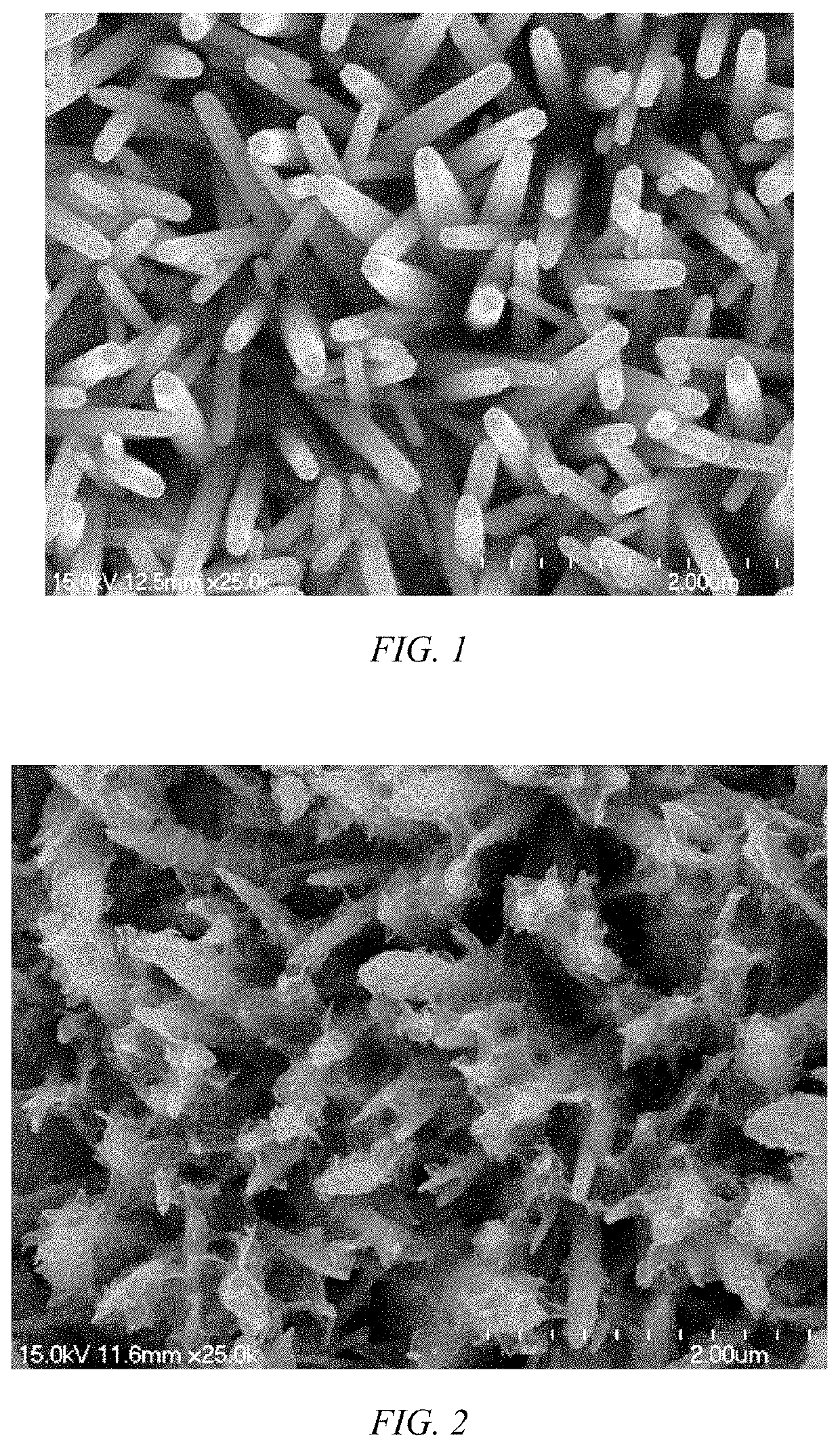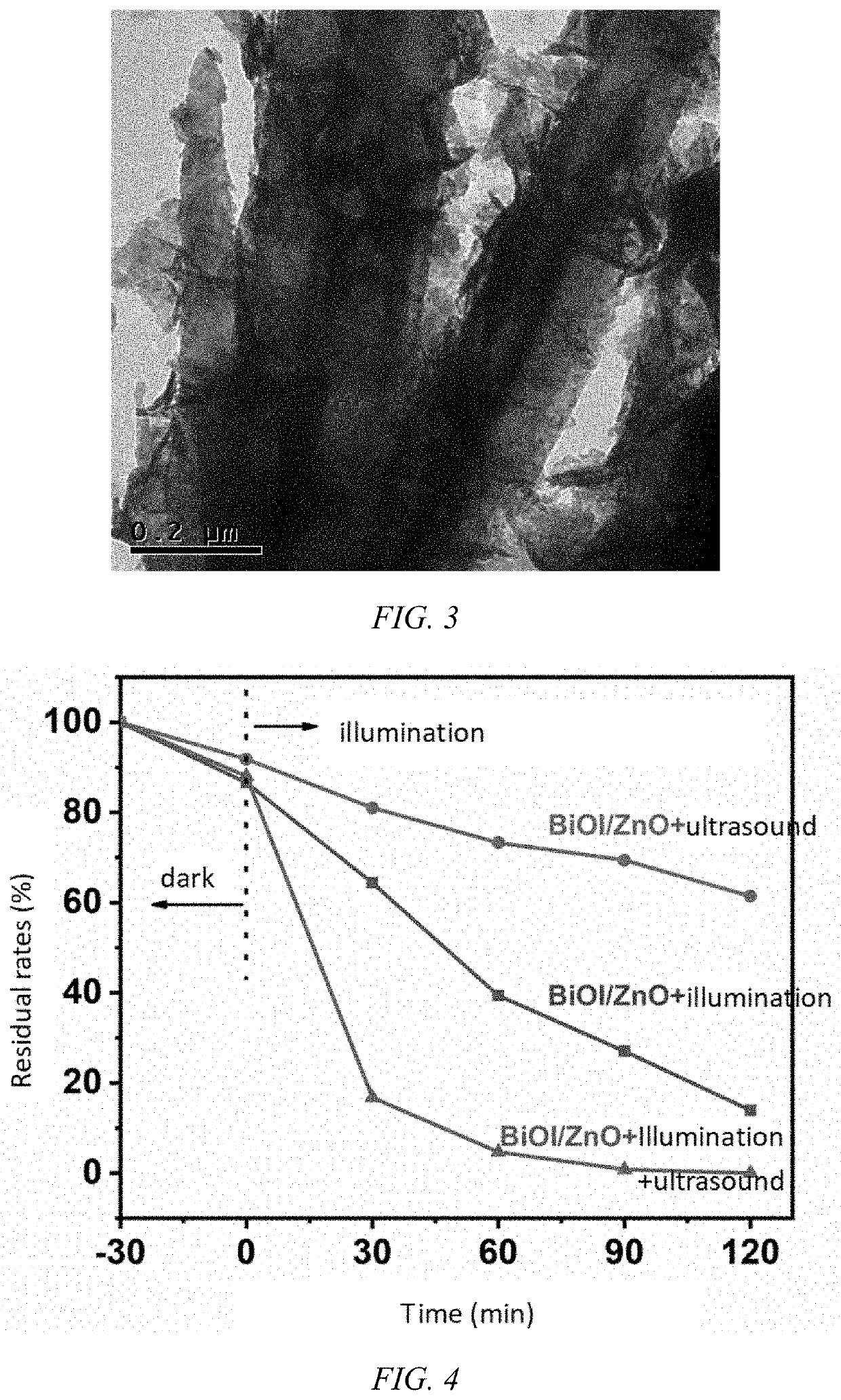Bismuth iodide oxide / zinc oxide composite and preparation method therefor and application thereof in piezoelectric photocatalytic removal of organic pollutants
a technology of iodide oxide and zinc oxide, which is applied in the field of nanocomposites and piezoelectric photocatalysis, can solve the problems of reducing the utilization efficiency of sunlight, shortening the supply of clean energy, and most serious problems facing the world, and achieves the effects of simple synthesis method, convenient synthesis, and regular morphology
- Summary
- Abstract
- Description
- Claims
- Application Information
AI Technical Summary
Benefits of technology
Problems solved by technology
Method used
Image
Examples
embodiment 1
[0034]Preparation of zinc oxide seed layer on ITO glass, the specific steps are as follows:
[0035]First, ITO conductive glass (1.5*3 cm2) is washed with a mixture of ethanol, acetone and deionized water (the volume ratio is 1:1:1) in an ultrasonic instrument for 30 minutes, then dissolve 0.7437 g of zinc nitrate hexahydrate and 0.3505 g of hexamethylene tetramine in 5 ml of deionized water separately to obtain zinc nitrate aqueous solution and hexamethylene tetramine aqueous solution respectively; take clean ITO glass and put it on the spin coating instrument, and drop about 1 ml of the above zinc nitrate aqueous solution and hexamethylene tetramine aqueous solution on the conductive surface of ITO glass successively, spin coating at 2000 rpm for 30 s, and then stand for 5 minutes; After the above operations are completed, dry and put into the tubular furnace, keep the temperature at 320° C. for 30 minutes in air atmosphere, and the heating rate is 5° C. / min (room temperature to 320°...
embodiment 2
[0036]The specific steps for the preparation of ZnO nanorod arrays are as follows:
[0037]Weigh 0.7437 g of zinc nitrate hexahydrate and 0.3505 g of hexamethylene tetramine and dissolve them in 50 ml of deionized water respectively. After stirring for 10 minutes, mix them and continue stirring for 10 minutes to obtain the precursor solution (the concentration is 25 mM); the ITO conductive glass with ZnO seed layer prepared in embodiment 1 is obliquely inserted into the inner tank of the reactor with the conductive surface facing down, the angle is about 60°, the precursor solution is poured into the inner tank of the reactor, the volume is about 80% of the inner tank capacity, sealed, and put into the oven at 90° C. for reaction for 6 hours. Cool naturally, open the reactor, take out the ITO glass, and wash its front and back sides with deionized water and ethanol, dry to obtain zinc oxide nanorod arrays for use in embodiments 3 to 5.
[0038]FIG. 1 is a scanning electron microscope diag...
embodiment 3
[0039]Preparation of bismuth iodide oxide / zinc oxide nano array composite (10% BIOI / ZnO), the specific steps are as follows:
[0040]Weigh 48.5 mg of bismuth nitrate pentahydrate and 16.6 mg of potassium iodide and dissolve them in 40 mL of ethylene glycol monomethyl ether (the concentration is 2.5 mM), stir vigorously for 25 minutes, move it into the inner tank of the reactor, obliquely insert ITO glass with zinc oxide nanorod array into the inner tank of the reactor with the conductive surface downward at an angle of about 60°, seal it, and put it into the oven for reaction at 160° C. for 12 hours. After natural cooling, take out ITO glass, wash it with deionized water and ethanol, and dry it in the oven at 60° C. for 6 hours to obtain a composite with a Bi:Zn molar ratio of 10%, recorded as 10% BiOI / ZnO nano array composite.
PUM
 Login to View More
Login to View More Abstract
Description
Claims
Application Information
 Login to View More
Login to View More - R&D
- Intellectual Property
- Life Sciences
- Materials
- Tech Scout
- Unparalleled Data Quality
- Higher Quality Content
- 60% Fewer Hallucinations
Browse by: Latest US Patents, China's latest patents, Technical Efficacy Thesaurus, Application Domain, Technology Topic, Popular Technical Reports.
© 2025 PatSnap. All rights reserved.Legal|Privacy policy|Modern Slavery Act Transparency Statement|Sitemap|About US| Contact US: help@patsnap.com


